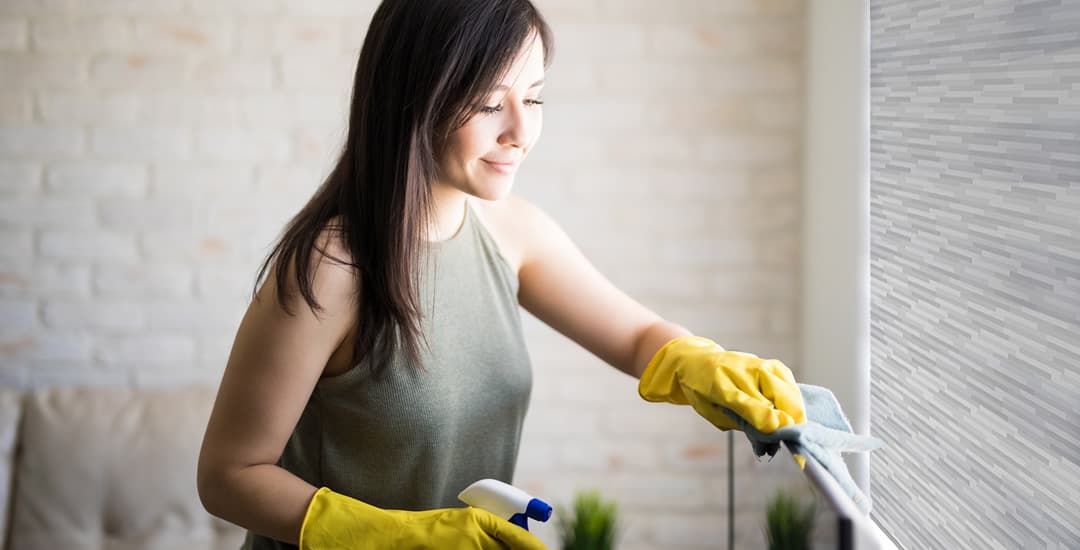
Roller blinds are the type of blinds that are made of a solid piece of fabric wrapped around a tube, which rolls up and down when raised and lowered.
They’re probably the most popular and versatile type of window blinds of all, and so we get a lot of questions about their cleaning. Roller blinds are pretty robust and even really manky-looking ones can generally be restored to their former glory without much hassle, but roller blinds are almost universally made of either polyester or PVC/vinyl, and polyester is a bit more delicate when it comes to cleaning and general care.
Whatever your roller blinds are made of, this blog post will tell you the best thing to use to clean blinds of this type, and why – and how – to clean roller blinds without taking them down.
Contents
- Section 1: Should you take roller blinds down to clean them?
- Section 2: What is the best thing to use to clean blinds that aren’t too grubby?
- Section 3: How to clean roller blinds that have gone beyond basic dusting
- Section 4: How to clean polyester roller blinds
- Section 5: How to clean PVC or vinyl roller blinds
- Section 6: Can you wash roller blinds in the bath?
Should you take roller blinds down to clean them?
Generally, no… So, what is the best way to clean blinds without taking them down, and why shouldn’t you take them down in the first place?
When it comes to cleaning roller blinds, you’re far better off leaving them in situ attached to the tube. Really the only reason you might be tempted to do otherwise is if you’re considering washing them in the bath (which may be ok, as we’ll cover later) or throwing the blind in its entirety in the washing machine; which will not be ok at all.
If washing roller blinds in the washing machine is your plan, you might as well save time and throw the blind straight in the bin, as this is all it’s likely to be good for after!
Polyester roller blinds ideally need washing by hand while still hanging, as otherwise there’s a high likelihood that the fabric will discolour, lose its stiffness, become bobbled, and get creases and folds in it that can’t be removed whatever you do. PVC or vinyl roller blinds, on the other hand, come with a few more cleaning options.
What is the best thing to use to clean blinds that aren’t too grubby?
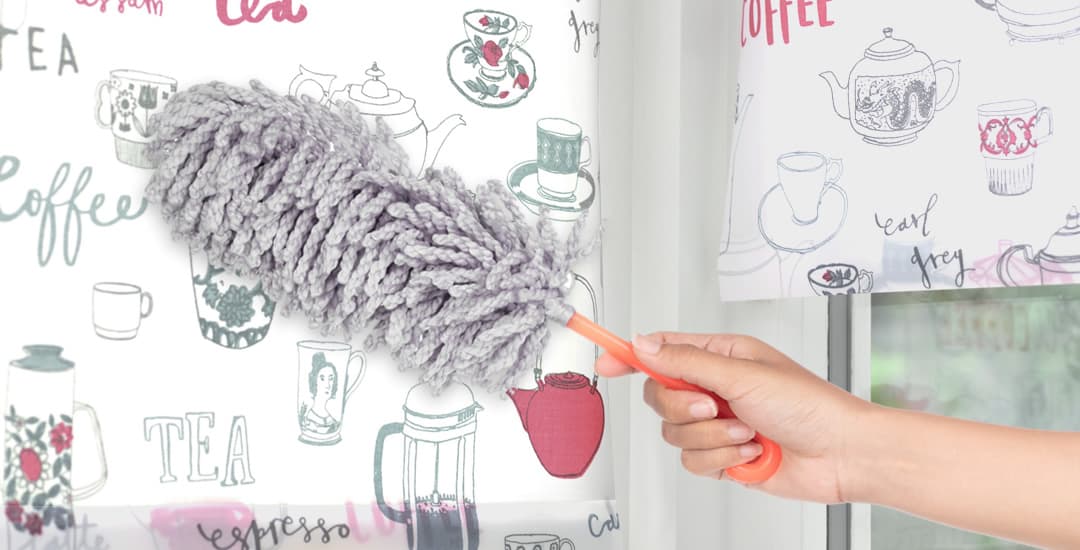
You can keep your roller blinds in good nick and delay the need for a more intensive cleaning by giving them some cursory attention as part of your regular household cleaning, and this is little to no effort at all, even if your idea of “cleaning” means “masking the issue and spraying Febreeze.”
Because roller blinds hang vertically they don’t tend to get overly dusty, albeit if they’re left in the same position for weeks they might develop something of a fur coat across the top. This means you can just give them a quick dusting off with a feather duster or microfibre cloth (to avoid them building up static and attracting the dust right back), or even your vacuum cleaner’s upholstery brush attachment. Keep a hold of the bottom of the blind if using the vacuum cleaner for this, so that the fabric doesn’t get creased.
This approach to cleaning roller blinds will tend to be absolutely all that’s needed for months or even years at a time, unless your blinds are hung in a bathroom or kitchen and so, subject to moisture and potentially for kitchens, the presence of fats and oils in the air.
How to clean roller blinds that have gone beyond basic dusting
So your blinds have been up in your kitchen or bathroom for a while, or your kid decided they’d look better with some spaghetti hoops on them; what is the best way to clean blinds without taking them down if they’ve gone beyond the point at which simple dusting can help them?
This depends first up on whether your blinds are made of polyester or PVC/vinyl. If in doubt or it isn’t obvious from the look and feel of your blinds, it is safest to assume that your roller blinds are made of polyester, simply because the majority of roller blinds are made of polyester. Polyester is also rather more delicate and so it is worth erring on the side of caution if you’re unsure, to avoid damage.
That said, if you chose roller blinds for a bathroom or kitchen specifically, these are highly likely to be made of PVC or vinyl.
How to clean polyester roller blinds
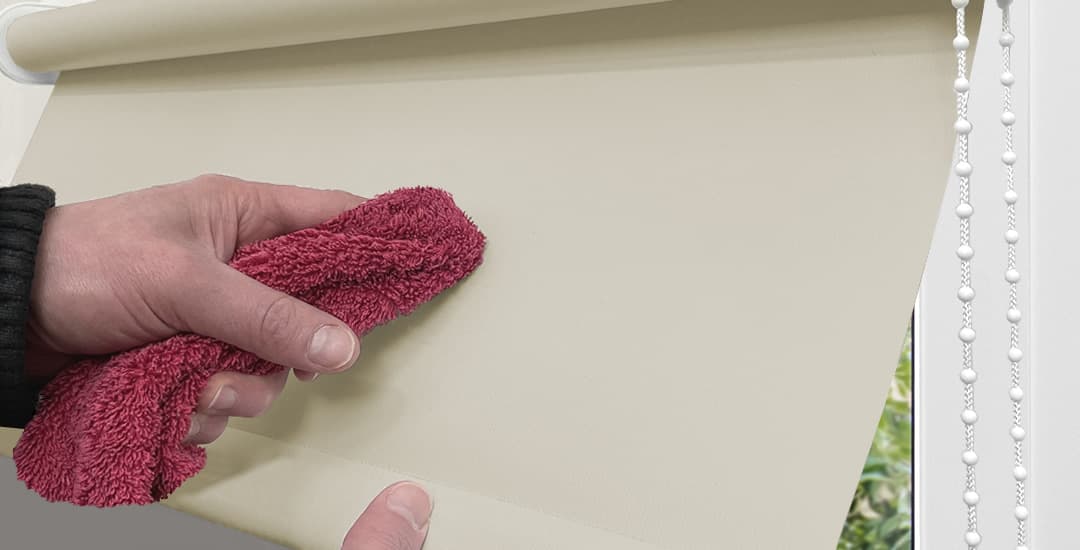
So, to clean polyester roller blinds or if you’re not sure about the fabric and don’t want to take chances, first up remove any surface dust as directed above. Then:
- Use a damp cloth (not soaking wet) or even baby wipes to wipe or dab at any marks or stains.
- Wipe the blind in one direction from top to bottom with the blind fully extended.
- Avoid getting the fabric too wet, as this might dissolve the stiffening agent that makes it hang correctly.
- Repeat on the back if needed.
- Leave the blind fully extended to air dry naturally.
- Don’t be tempted to roll your blind back up again until it is fully dry, otherwise it might get mouldy and become the answer to the “what’s that funky smell in here?” question that’s going to keep coming up in the future.
- Also, don’t use bleach or any other harsh or abrasive chemicals, as this is apt to discolour or ruin the fabric itself. Stick to water that is warm rather than hot for all of these same reasons.
How to clean PVC or vinyl roller blinds
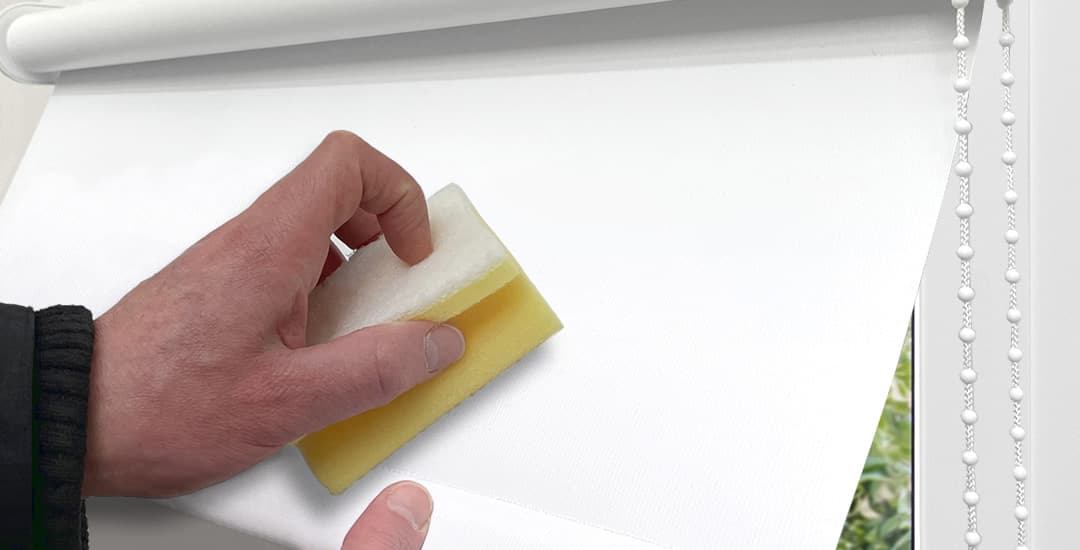
PVC or vinyl window blinds are a great choice for bathrooms and kitchens, but they’re also suitable for any room of the house. These are a bit more hardcore than polyester roller blinds as they’re water resistant, fungal resistant (so that they don’t tend to develop mould in damp environments, just remember to dry off excessive amount of water before rolling them back up), and flame retardant too.
All of this means they can take a bit more of a beating than their polyester cousins, and so the best thing to use to clean vinyl or PVC roller blinds is… Still a baby wipe or cloth/sponge. You can go a bit wilder about it though, and throw in some soap or washing detergent, and use slightly warmer water as well, albeit this still shouldn’t be hot-hot.
PVC and vinyl roller blinds can be gotten properly wet when cleaning them, but ironically because they’re also waterproof, any stains and marks are going to be on the surface only and so that much easier to remove.
As is the case with cleaning polyester roller blinds, work from the top to the bottom of the blind and repeat on the back; using a scrubbing motion if needed, and rinsing your sponge or cloth regularly to ensure you’re not just moving the dirt around.
Can you wash roller blinds in the bath?
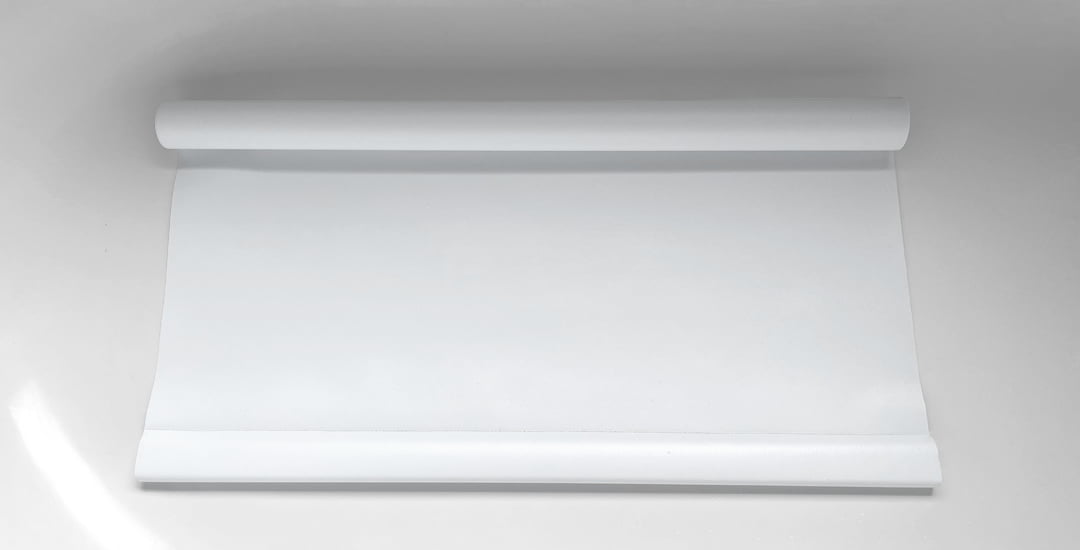
Generally, you’ll make cleaning roller blinds simpler and less prone to going wrong if you keep them on the tube and hung up for washing. That said, if your blinds are made of PVC or vinyl AND the roller tube itself is not made of cardboard (which tends to only be the case with very old-style roller blinds, but check anyway) you can indeed wash or rinse them off in the bath.
This means first taking your blind down and so, removing it from its fixing bracket; once you’ve done that, here’s how to wash PVC or vinyl roller blinds in the bath:
- When you’ve freed your blind from the fixing bracket, remove both the control end and the pin end from inside of the roller tube (these contain springs and potentially other metal parts that may seize up or rust if they get soaked).
- Fill the bath with warm water and either mild detergent or soap.
- Place the blind in the bath and leave it to soak for no longer than half an hour, or less if it isn’t too grimy.
- Use a soft scrubbing brush or a sponge to scrub the blind front and back.
- Rinse, and repeat if needed.
- Empty the bath and blot the blind dry as best you can with a towel or a leather chamois.
- Replace the blind’s ends and re-hang the blind on its brackets.
- Leave the blind fully extended until it is completely dry.
If you have any questions about cleaning roller blinds or want to find out what roller blinds that you purchased from us historically are made of before you get too soap-happy with them, get in touch and we’ll do our best to help!





Hello, just been reading the best way to wash vinyl roller blinds for the kitchen and bathroom. There are some marks of black mould on them, so is there a spray I can use and leave for a while before cleaning? thank you.
Thank you for your comment.
The safest method is to try some washing-up liquid to remove the mould. If that doesn’t work, you can try a mixture of lemon juice and white vinegar. Leave it on the mould for about 30 minutes to an hour, then thoroughly wash it off. If that is also unsuccessful, you can use a black mould spray such as Cillit Bang black mould remover. This will almost certainly remove all the mould. Just keep in mind the bleach in the spray may discolour the blind if left on for too long.